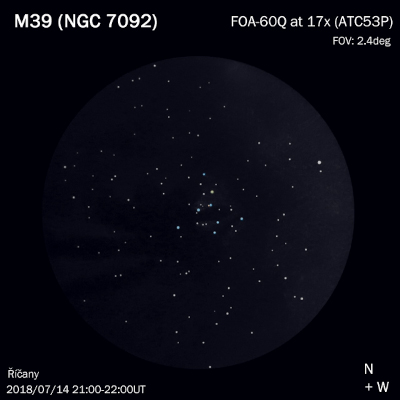
15x50mm IS binoculars (6/19/09): excellent at 15x with 25-30 stars resolved in a triangular outline. B68, a long dark streamer, is very prominent in the field to the southeast.
10x30 IS binoculars (6/13/07): naked-eye fuzzy patch is well resolved into ~15 stars in the 10x30 binoculars and approximately two dozen in the 15x50s. To the south of M39 begins the long dark streamer, Barnard 168, which is striking in 15x50 IS binoculars. This dark lane leads to the Cocoon Nebula (IC 5146), which is not visible in binoculars.
Charles Messier discovered M39 = NGC 7092 = h2126 on 24 Oct 1764, although as a naked-eye object it was probably noticed much earlier. On 27 Sep 1788 (sweep 866), WH logged "consists of such large and straggling stars that I could not tell where it began nor where it ended. It cannot be called a cluster." JH recorded on 14 Sep 1829, "A * 7m, one of a large loose cluster of stars 7 .... 10m; very coarsely scattered, and filling many fields."
200/250mm - 8" very bright, very large, 30' diameter, triangle shape, includes four bright stars mag 7 and ten fairly bright stars mag 8-9. Large and scattered so needs very low power. Partial resolution in 8x50 binoculars. Naked-eye cluster in a dark sky.
300/350mm - 13.1" (9/9/83): ~75 stars visible at 62x including 15 bright stars.
400/500mm - 17.5" (7/31/92): very bright, very large, about 30' diameter, scattered. Includes 18 bright stars mag 7-8. Most of the brighter stars form a triangular outline although a few bright stars are inside and outside. The bright star at the SE corner has about six faint stars close following. Includes several wide double stars. The bright stars are superimposed on a background of 100-150 faint stars. Fairly uniformly distributed though many stars are in short arcs and winding lanes. The faint stars are no richer than the Milky Way concentration. Best view with 20 Nagler at 100x.
Notes by Steve Gottlieb